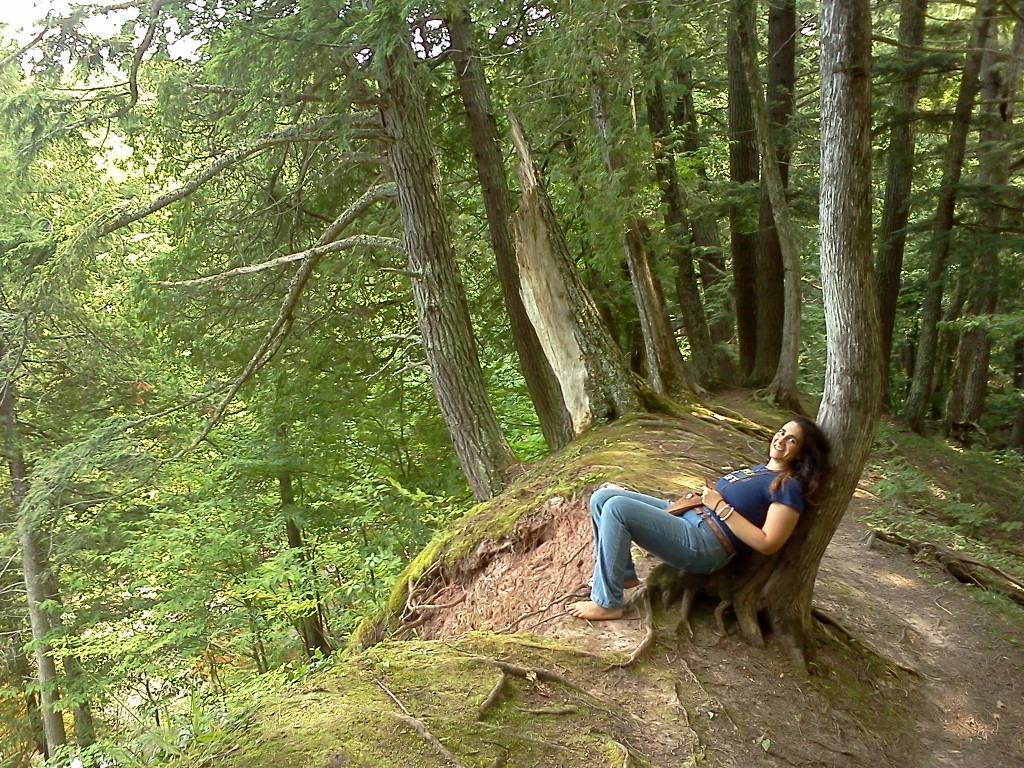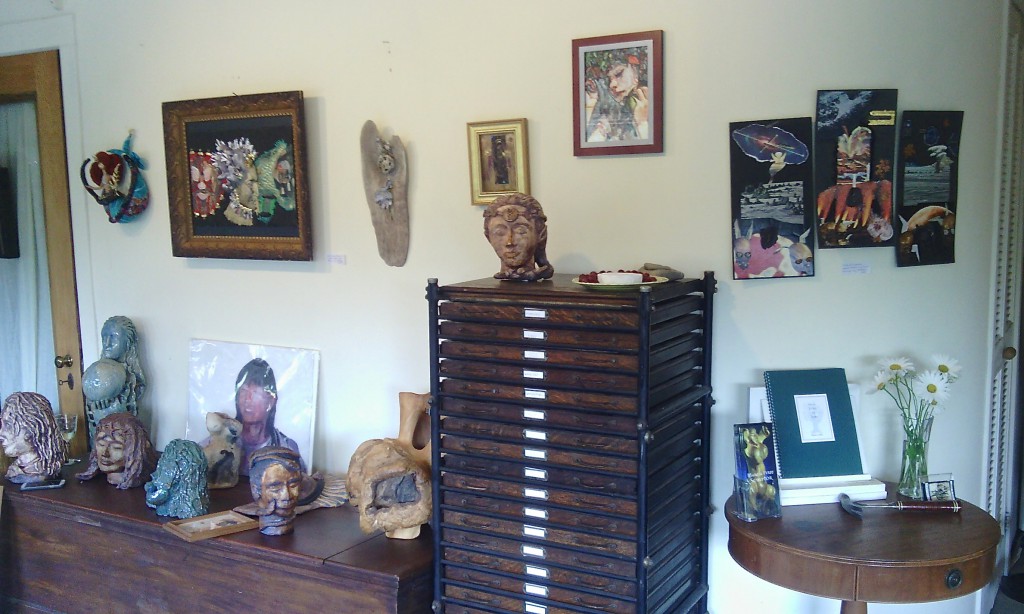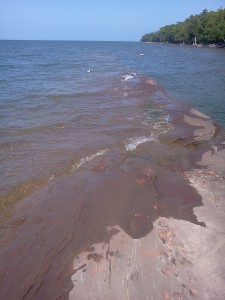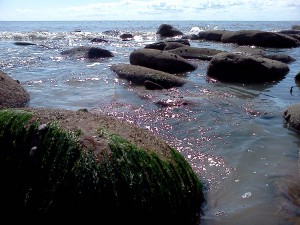
Hiking into the Porcupine Mountains, backcountry camping, August 2014. Thanks to Jeff Nixa for the photo!
While hiking out of the Porcupine Mountains, I set down my backpack for a rest. Here a mighty Eastern hemlock had fallen. (Not in this photo, though!) The former treetop had been cut apart and set aside, presumably by a ranger. A few rounds were at the path’s edge, and rather than lean on them, I made a short climb atop the long trunk.
I settled quietly while sitting upright, noticing the far-away roots splayed sidewise, partly lodged into the Earth. I bounced a little, and the tree gave freely without threat of breaking. Laying on my backbone, I scanned the old-growth canopy and a wide gap. Both the silence and sound of forest sunk in, as did my body along the hemlock.
Then way, way above and over yonder from another hemlock, something very small was dangling — in fact, lowering. It was an inch worm! An inch worm was descending from “on high”, attached by a thread invisible to the naked eye. Of course, “Inchy” was doing what’s in its nature, though the sight struck me as strange — midair, a likeness to floating.
The impressive view seemed impossible, this wee thing a great distance between the solid ground below and the branch from which it must be latched. Reflecting on the encounter, it happened because I set aside my typical view from the “upright” or vertical stance. Instead, I had laid spine-to-spine with a fallen hemlock. Well, interesting things happen when “gettin’ down” with the Earth — in other words, “going” horizontal.
º º º º º
My awareness about “experiments” with the horizontal plane arose thanks to an exchange with artist Marcia Perry. The “ah-ha” emerged while discussing historical challenges around exhibiting my artist’s book The Vision Journal (2013), hereafter fondly dubbed VJ. Scrapbook-sized and loosely-bound, VJ requires a wide flat surface for support. With its numerous pages — many of which are layered with materials — a paired table and chair invite viewers not to rush.
Maybe you’ve noticed, but conventional exhibitions do not typically offer tables and chairs! In fact, ever since I’ve been exhibiting VJ, there always seems to be a sticky point. One of the galleries I recall doubled as a performance venue. In this case, the curator offered to exhibit the work when I could be physically present and there was not a performance taking place. So, VJ and I enjoyed the opening day for the month-long art show, then went home together!
Also, at an “old-school” exhibition, viewers do not touch art. Yet VJ is an interactive work offering an intimate experience. Another curator initially placed VJ on a very high pedestal. I discovered this placement when I came by to display my artist statement. What I also found was a rather short artist turning VJ’s pages but who was not able to see them. Imagining it helpful, I rearranged my work for “proper” viewing — oh, and added a stray chair from the building.
This impulse to “lower” VJ felt quite natural, especially since I thought there was an agreement with the curator. As with previous exhibitions, I had been “up front” about the matter of placement: flat, wide, low, and with a chair. Since nothing contrary was voiced in our exchanges, I didn’t imagine the curator would mind the change . . . but of course they did! I mean, they had put VJ “up high” for some reason.
º º º º º
What happens when the horizontal and the vertical planes collide — or coincide? Well, it’s a matter of perspective! That is, how one looks at the situation: upright or parallel, still or moving , maybe even alternating between these positions and paces. Consider standing waist deep in the Big Water as waves pound. What’s it feel like to try and keep anchored atop shifting sand, with waves beating against your “uprightness”? Imagine what it’s like for the water — in all its fluidity and on its natural course — to break across the body.
And how does perspective change, for instance, when the vertical “goes” horizontal? Perhaps the upright becomes level, or even the stillness moves. In the Big Water besides resisting, you may float or ride the wave, even swim. Consider the sensation of water surfing along contours without barrier. Indeed, point of view has much to do with not just the answers but also the questions.
My favorite horizontal experiment from the summer– at least thus far! — is to stretch out alongside the Big Water. The stable surface may be a sandy beach at Lake Michigan or a wide rock surrounded by Lake Superior. Belly-down and head turned to view the horizon, the water flows. And above the water, the clouds too flow with the wind. After a time, the physical understanding that the Earth is curved begins to sink in, as the waves constantly come.
In some moments, the stillness of lying is overcome by a sensation of movement. Maybe it’s possible from the horizontal plane actually to feel the Earth’s rotation. Maybe there is a way — or perhaps a time — that one can overcome ingrained vertical stances. Maybe it’s through humbling one’s height, what we colloquially call “getting down to Earth”, that we become aware how the ground’s always holding us up — that is, when we’re not floating or riding a wave.
º º º º º
My heart warms to share how VJ didn’t stay on that tall pedestal! Instead, a collaborative placement was possible with the help of a grounded mediator. Looking back, it seems that the curator and I sorted through our our own — as well as one another’s — “uprightness” and fluidity. Better than just a solution, we shared a healing resolution as we interacted over a span of time. Ultimately, we benefited in distinct yet complimentary ways, as we shifted through positions, stillness, movement.
It’s doubly warming that VJ is on exhibition right now in Saugatuck, Michigan, in the Goddess Art Show at the Marcia Perry Art Studio. The closing reception is September 14, and new works are added over the show’s six weeks. If you’re in Southwest Michigan or able to get there, check it out! I enjoyed the opening in early August, before my current travel here in Europe among loved ones, Quakers, shamans, and artists.
A peek at the Goddess Art Show is available with my online photo gallery (just follow the link!). For sale are my original transfers with a natural solvent on handmade paper, and also the mixed-media collage She’s Not a Monster (2014). By the way, just like collages I’ve created up to now, the transfers were made from the horizontal plane!
Thanks, readers of Dey of the Phoenix, for staying tuned. I’m excited that you’re part of the creative-healing journey. Currently I’m creating limited-edition book art, Emergence, entitled in parallel with my last performance season. I’ve created an online album with ongoing updates (“link” away!). The release in Kalamazoo, MI, is October 18, with a Lansing event sometime between late November to early December. Wising you an inspired day or night — wherever you be!

Goddess Art Show at Marcia Perry’s Art Studio, Saugatuck, MI. August 2014. My mixed-media collages are on the wall (black backgrounds)




